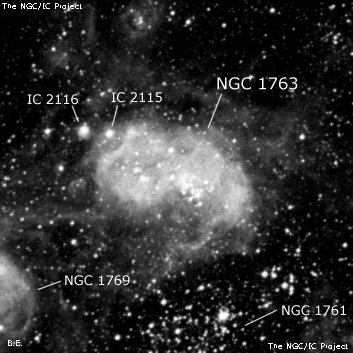
James Dunlop discovered NGC 1763 = D 230 on 6 Nov 1826 with his 9" reflector and described a "very faint rather elliptical nebula, about 2' diameter. This is the preceding largest of three nebulae forming a triangle". Dunlop made two observations and his position is ~12' south of the "Bean Nebula", but his description seems to apply.
John Herschel made 5 observations of this nebula, describing it on one sweep as "a vB, vL neb with stars (the chief of which in the anterior part of the neb taken) of a crooked rounded oblong starpe. A fine object. See fig. 3. Plate III." His excellent sketch includes NGC 1760, 1761, 1763 and 1769. Joseph Turner also sketched the complex between 17 Apr and 21 Apr 1879 with the Great Melbourne Telescope. The gaseous nature of NGC 1763 was discovered by Annie Jump Cannon on spectrum plates taken at Harvard's Arequipa station in 1897.
300/350mm - 13.1" (2/17/04 - Costa Rica): this emission nebula and cluster is set in fascinating field of several clusters and HII regions including NGC 1761, 1769, and 1773. The nebula is fairly bright, large, very elongated WSW-ENE, 4'x2'. A few stars are superimposed on the nebulosity. The roughly oval outline is irregular and the HII region appears brighter on the WSW side near a rich group of stars at the WSW tip. A couple of mag 11 stars are close off the NE end. IC 2115 and IC 2116 comprise the western and eastern portion of this object. After viewing this group of objects, the LMC which was well past the meridian disappeared behind some low clouds.
600/800mm - 30" (11/4/10 - Coonabarabran, 264x): The Bean Nebula complex (LHA 120-N11) is the second largest stellar nursery in the LMC after the Tarantula Nebula. The showpiece object is NGC 1763, which sits near the center of a stunning field of emission nebulae and clusters including NGC 1760 7' S, NGC 1761 3' S, NGC 1769 6.5' SE, NGC 1773 8' ENE and NGC 1776 11' E. NGC 1763 is a very bright, very large irregular nebula, shaped like a kidney-bean or a fetus. The main body extends 5'x3', elongated SW-NE with a bulbous portion on the northeast side and an indentation (weaker nebulosity) on the south side. Overall the surface brightness is very high, though uneven, and much fainter haze and filaments flow out from the Bean in most directions. Within the main body, the nebula is brightest in a loop on the southwest side and secondly in a section on the northeast side.
LH 10, a large cluster or OB-association (youngest in the LMC-N11 complex) with roughly two dozen resolved stars is involved with the nebula. LH 10 includes a number of 12-13 mag stars (several of which are massive O3-type stars), many in an elongated 1' group on the southwestern side. The brightest mag 11.7 "star" (PGMW 3070) is actually an extremely compact cluster with 18 stars resolved by the HST. A wide pair [17" separation] of mag 11.9 and 12.9 stars (O3-type HD 268721 and O8-type PGMW 3223) is ~1.5' ENE of the main stellar group; one of these may be IC 2115. At the northeast edge of the cluster is mag 11.3 HD 268726 (blue supergiant) and 45" further east is IC 2116, a high surface brightness HII knot of ~15" diameter. Very faint haze at the NE side of NGC 1763 bulges towards IC 2116. The surrounding field is rich in stars between the individual objects with some locally brighter patches of nebulosity.
Notes by Steve Gottlieb